Heracles’ 12 Labors: Exploring the Mythic Trials of a Greek Demigod
Overview of Heracles’ 12 Labors
The 12 Labors of Heracles are a fascinating collection of stories that form a fundamental part of Greek hero myths. Ordered by King Eurystheus, these tasks aimed to test Heracles’ abilities and character. Each labor presented Heracles with immense challenges, from defeating mythical creatures to completing seemingly impossible feats. As we explore these tasks, we uncover not just the physical prowess of Heracles but also the deeper moral lessons embedded in these myths. Each labor stands as a testament to Heracles’ strength, ingenuity, and resilience, illustrating the enduring appeal of his legend in Greek mythology. Each task of Heracles’ 12 labors was more daunting than the last.
Confronting the Nemean Lion
Hercules’ first labor marked the beginning of his legendary journey: slaying the formidable Nemean Lion. The beast, born of Typhon and Echidna, terrorized Nemea with its impervious hide that rendered mortal weapons useless. Tasked by King Eurystheus to atone for past sins, Hercules faced this daunting challenge with his iconic club and unmatched resolve. Initially, Hercules’ strikes proved futile against the lion’s impenetrable defense. Undeterred, he relied on strength and cunning, engaging the beast in close combat. Grappling with the lion, Hercules exploited its vulnerability by targeting its throat and mouth, ultimately overpowering it and strangling it to death. The demigod skinned the lion, using its hide as an indestructible cloak and its head as a helmet, symbolizing his triumph.
This victory not only ended the lion’s reign of terror but also showcased Hercules’ ingenuity and determination, setting the tone for his subsequent labors. The tale of the Nemean Lion endures as a testament to the power of perseverance and resourcefulness in overcoming seemingly insurmountable obstacles.

Battling the Lernaean Hydra
The Lernaean Hydra dwelled in the swamps of Lerna, and its venomous breath and blood made it a truly terrifying foe. Each time Heracles struck the creature, two more heads would grow in place of the one he severed, making it seem like an impossible task. With Iolaus by his side, they devised a clever strategy: after Heracles cut off each head, Iolaus quickly used a torch to cauterize the stump, stopping the heads from regenerating.
After a fierce battle, Heracles finally killed the beast by cutting off its immortal head and burying it under a massive rock. The Hydra’s blood, however, was poisonous, and Heracles dipped his arrows in it, making them deadly weapons for future tasks. This task highlights themes of resilience and ingenuity, teaching us the value of creative problem-solving in the face of adversity.
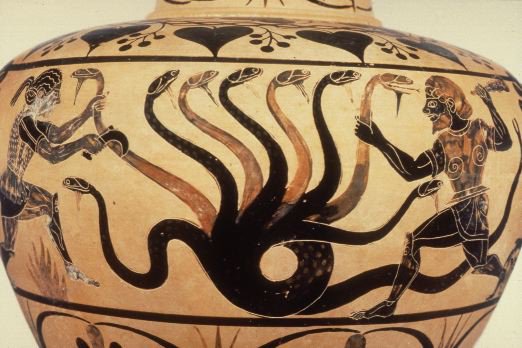
Capturing the Ceryneian Hind
In his third labor, Heracles was tasked with capturing the elusive Ceryneian Hind. This sacred deer was so swift it could outpace an arrow. After an entire year of relentless pursuit, Heracles finally managed to catch the Ceryneian Hind by cornering it in a secluded glade. However, respecting Artemis’ sacred bond with the creature, he carefully captured it alive, intending to bring it back without harm.
Upon returning, Heracles sought Artemis’ forgiveness for his actions, knowing that even in fulfilling his labor, he had to tread carefully around the gods’ will. This labor emphasizes the importance of respecting nature and divine will, a key lesson in Greek mythology.

Securing the Erymanthian Boar
Heracles’ fourth task involved capturing the wild Erymanthian Boar. This task required Heracles to capture the boar alive. Heracles used his strategic skills to drive the boar into a snowdrift, where he caught it. After successfully capturing the beast, Heracles struggled with the boar’s immense strength and fury. He carefully restrained the creature, ensuring it remained alive, and began his long journey back to King Eurystheus.
Upon his return, the king was so terrified by the sight of the raging boar that he hid in a bronze jar, showing the immense power and fear the beast inspired, and further proving Heracles’ bravery and perseverance. This labor teaches us about determination and the importance of strategy in overcoming challenges.
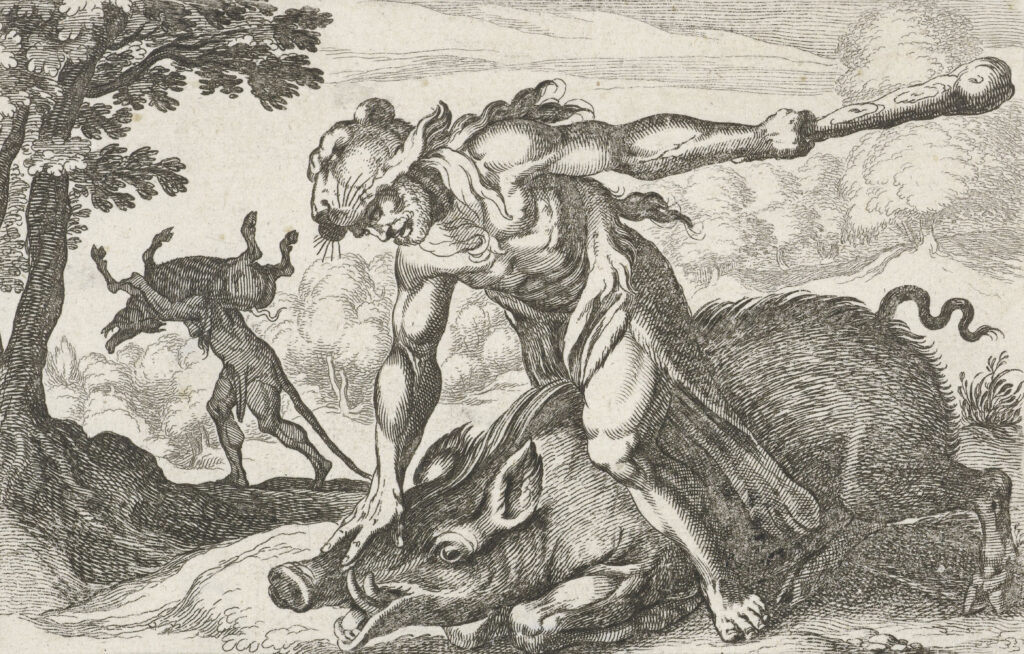
Cleansing the Augean Stables
For his fifth labor, Heracles had to tackle the monumental task of cleaning the Augean Stables, which housed thousands of cattle and hadn’t been cleaned in years. Instead of cleaning them by hand, Heracles devised a clever plan to reroute the rivers Alpheus and Peneus through the stables, washing away the accumulated filth in a single day.
This labor not only showcases Heracles’ ingenuity, but also his ability to think creatively under pressure. By finding an unconventional solution to a seemingly insurmountable problem, Heracles teaches us the importance of innovative thinking and resourcefulness. This labor also highlights the idea that intelligence and strategic planning can often accomplish what sheer strength alone cannot, a key theme in many Greek hero myths.
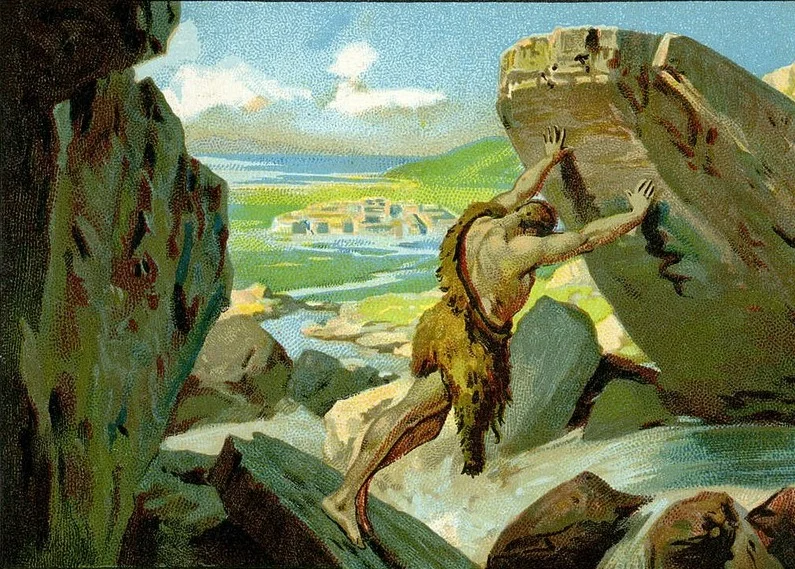
Dispersing the Stymphalian Birds
Heracles’ sixth task took him to the marshes of Stymphalia, where he faced a daunting challenge: driving away the Stymphalian Birds. These formidable creatures had metallic feathers that could be launched like arrows, making them a significant threat. Heracles received assistance from Athena, who provided him with a special rattle to startle the birds. Using the rattle, he managed to scare them into the sky, where he could then shoot them down with his arrows.
This labor showcases the importance of using the right tools and strategies to face seemingly insurmountable challenges. Additionally, it highlights the theme of divine assistance in Greek mythology, where gods often played crucial roles in aiding heroes. The Stymphalian Birds task reminds us that even the most dangerous obstacles can be overcome with the right approach and support, underscoring the value of wisdom and preparation in the face of adversity.

Subduing the Cretan Bull
Heracles’ seventh task involved capturing the formidable Cretan Bull, a beast that was wreaking havoc on the island of Crete. This bull had been released by Poseidon and was causing widespread destruction. Upon reaching Crete, Heracles wrestled the bull into submission using his immense strength and skill, ultimately managing to bring it back to King Eurystheus.
This labor underscores Heracles’ ability to confront and subdue chaotic forces, a common theme in Greek hero myths. By taming the bull, Heracles not only demonstrated his physical prowess, but also his capacity to restore order from chaos. The bull itself, a symbol of untamed power and divine will, highlights the importance of mastering one’s environment and the forces within it.
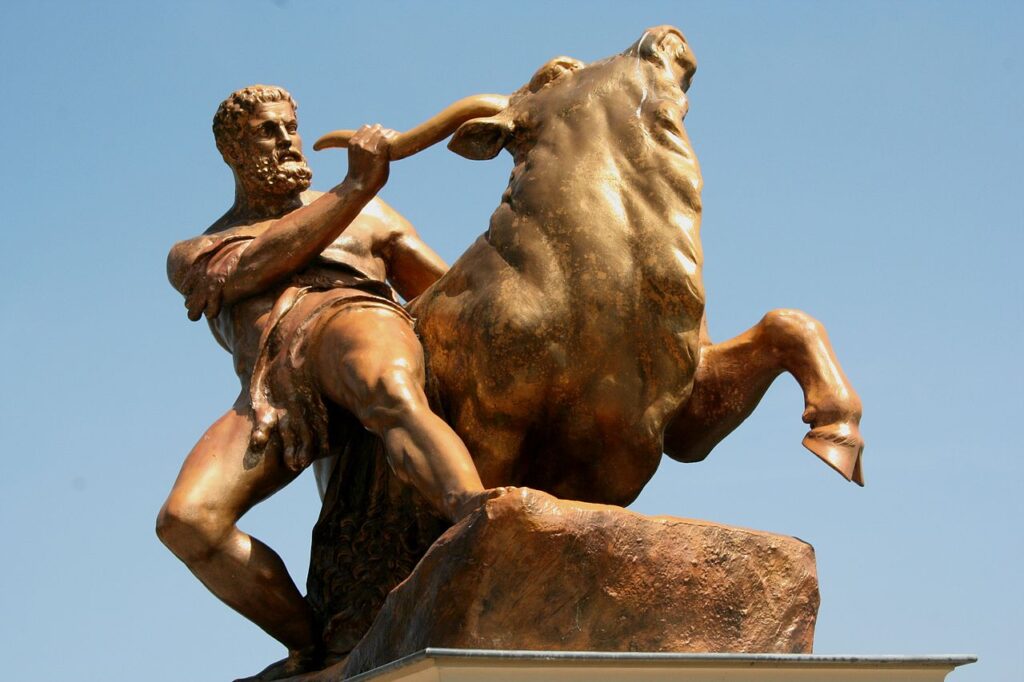
Taming the Mares of Diomedes
For his eighth task, Heracles faced the challenge of taming the fierce, man-eating horses owned by Diomedes, the Thracian king. These horses had a fearsome reputation, feeding on the flesh of unsuspecting victims. Heracles devised a cunning plan to deal with this perilous situation. He overpowered Diomedes and fed him to his own horses, which had the effect of taming them. This labor stands out as a testament to Heracles’ strategic thinking and ability to adapt to unexpected circumstances.
The task also offers insights into the themes of justice and retribution, as Diomedes met a fitting end by the very creatures he had used for violence. Heracles’ approach in this labor highlights the importance of using one’s intellect and resourcefulness to achieve goals, rather than relying solely on brute strength. By turning the situation to his advantage, Heracles demonstrated that cleverness and quick thinking are essential qualities for overcoming obstacles.
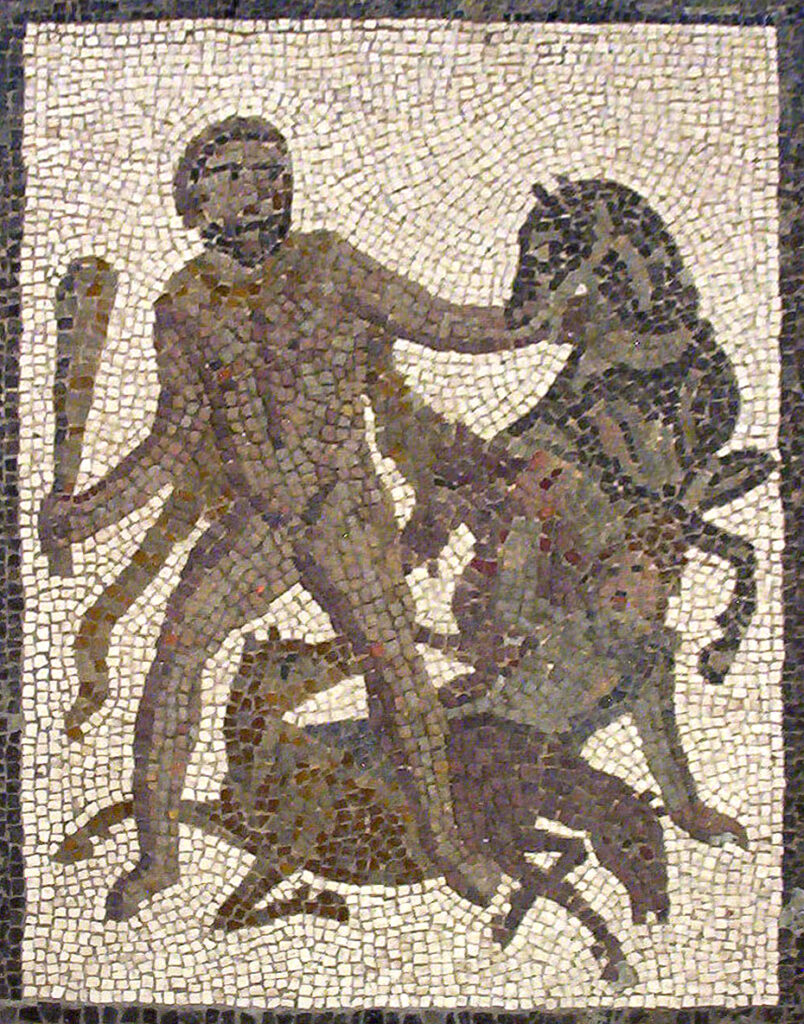
Acquiring Hippolyta’s Belt
Heracles’ ninth labor involved acquiring the belt of Hippolyta, the queen of the Amazons. The belt was a symbol of her authority and power, gifted by Ares, the god of war. Initially, Hippolyta was willing to give the belt to Heracles, recognizing his valor and understanding the purpose of his quest. However, Hera, always intent on complicating Heracles’ tasks, spread a rumor among the Amazons that Heracles intended to abduct their queen. This incited the Amazons to attack Heracles and his companions.
In the ensuing conflict, Heracles was forced to fight the Amazons and ultimately killed Hippolyta, taking the belt as a result. This labor underscores themes of trust and betrayal, as well as the unintended consequences that can arise from misunderstandings and interference. It also touches on the complex relationships between heroes and the gods, highlighting how divine interventions can alter the course of human actions.
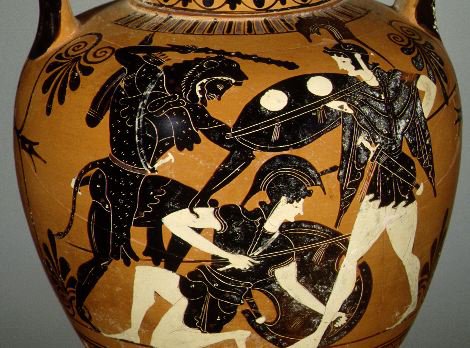
Gathering the Cattle of Geryon
Heracles’ tenth labor required him to gather the cattle of Geryon, a formidable giant with three bodies. This task was not only physically demanding but also required exceptional perseverance. The journey to Geryon’s island, Erytheia, was long and arduous, taking Heracles to the edges of the known world. Upon arrival, Heracles faced and defeated both the two-headed dog Orthrus and the herdsman Eurytion, who guarded the cattle. The final challenge was confronting Geryon himself, who wielded immense strength. Heracles used his powerful bow and arrows dipped in Hydra’s venom to defeat the giant, allowing him to secure the cattle.
This labor underscores the importance of endurance and resilience. It teaches us that even the most daunting tasks can be accomplished with determination and unwavering effort. Heracles’ journey to Erytheia and his subsequent victories over Orthrus, Eurytion, and Geryon illustrate the hero’s extraordinary perseverance and ability to push through physical and mental barriers. The story of gathering Geryon’s cattle emphasizes the value of persistence in achieving one’s goals, no matter how distant or difficult they may seem, reinforcing the timeless qualities that define a hero in Greek mythology.
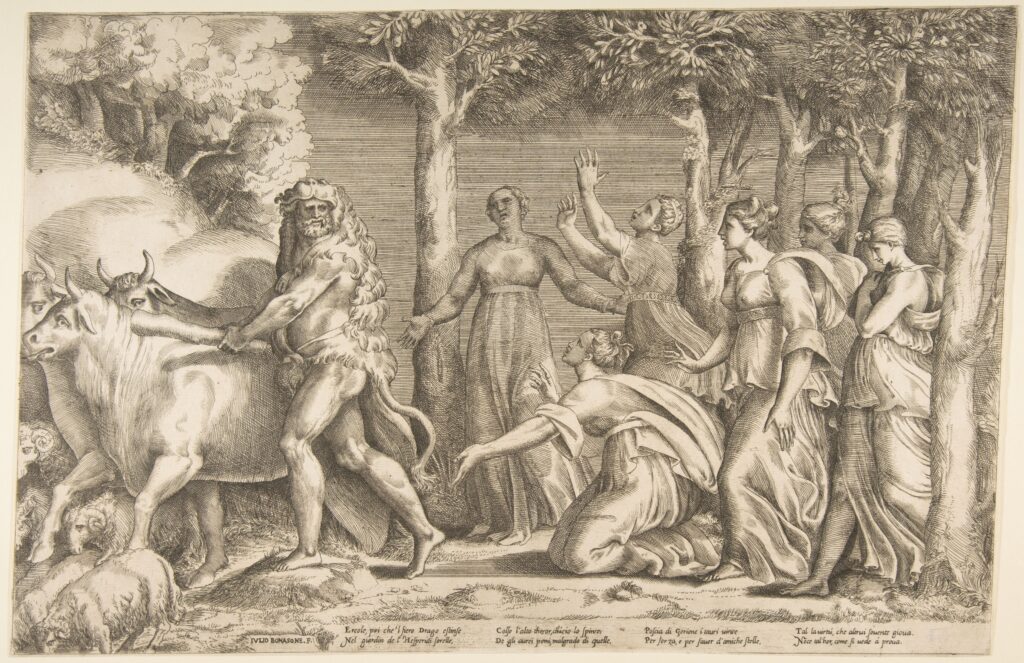
Retrieving the Apples of the Hesperides
Heracles’ eleventh labor required him to retrieve the golden apples of the Hesperides, a task known for its immense difficulty. These apples were guarded by a dragon. To succeed, Heracles enlisted the help of Atlas, the Titan condemned to hold up the sky. Heracles offered to temporarily take on Atlas’s burden if Atlas would retrieve the apples for him.
This task highlights the importance of collaboration and clever negotiation, as Heracles needed Atlas’s unique abilities to complete the task. It also emphasizes the theme of cunning over brute strength, a recurring motif in Greek mythology. Moreover, the golden apples themselves, often associated with immortality and divine favor, add a layer of symbolism to the labor, representing Heracles’ quest for redemption and eternal life. This task teaches us that sometimes achieving our goals requires seeking help and employing strategic alliances, rather than relying solely on individual effort. The story of retrieving the apples underscores the value of wisdom and resourcefulness in overcoming obstacles.

Seizing Cerberus
Heracles’ twelfth labor was to bring back Cerberus, the terrifying guardian of the underworld, without using weapons. To achieve this, Heracles had to venture into the depths of Hades. With guidance and permission from Hades, the god of the underworld, Heracles confronted Cerberus. Using his immense strength and bravery, Heracles managed to overpower the beast, known for its three heads, serpentine tail, and vicious nature.
This task required not just physical power but also a fearless spirit, as Heracles had to face the fears and dangers associated with the realm of the dead. Unlike his previous labors, this one had a uniquely spiritual dimension, symbolizing a confrontation with mortality and the unknown. By subduing Cerberus and leading him out of the underworld, Heracles demonstrated his ability to overcome not just earthly challenges but also the metaphysical boundaries between life and death.
This labor also highlights the theme of redemption, as Heracles’ ability to control Cerberus and return him to Hades safely was a testament to his worthiness and heroic status. The task illustrates the power of courage and the human spirit in facing the ultimate fears, reflecting broader themes in Greek hero myths about the cyclical nature of life, death, and rebirth.

Reflecting on Heracles’ Legacy
Heracles’ 12 Labors serve as a profound exploration of human character, emphasizing not only physical strength but also resilience, ingenuity, and moral integrity. Guided by the Oracle of Delphi, Heracles’ quest was a path to redemption, undertaken to atone for past transgressions. His service to King Eurystheus for twelve years was not merely about completing tasks but about personal growth and transformation. Each labor taught him—and us—vital lessons about facing challenges head-on, utilizing intelligence, and persevering through adversity.
From the wisdom gained in outsmarting the Hydra to the courage displayed in venturing into Hades to capture Cerberus, Heracles’ journey underscores the value of determination and strategic thinking. His story reflects the timeless qualities that define a hero, resonating deeply within Greek hero myths. The recurring themes of justice, responsibility, and the balance of power and control permeate his adventures, enriching the narrative with ethical dimensions.
Heracles’ legacy transcends the mere feats he accomplished; it encapsulates the enduring human spirit’s capacity for growth, redemption, and the pursuit of greatness. His 12 Labors continue to inspire, reminding us of the profound potential within each of us to overcome our own trials and emerge stronger.
2 comments